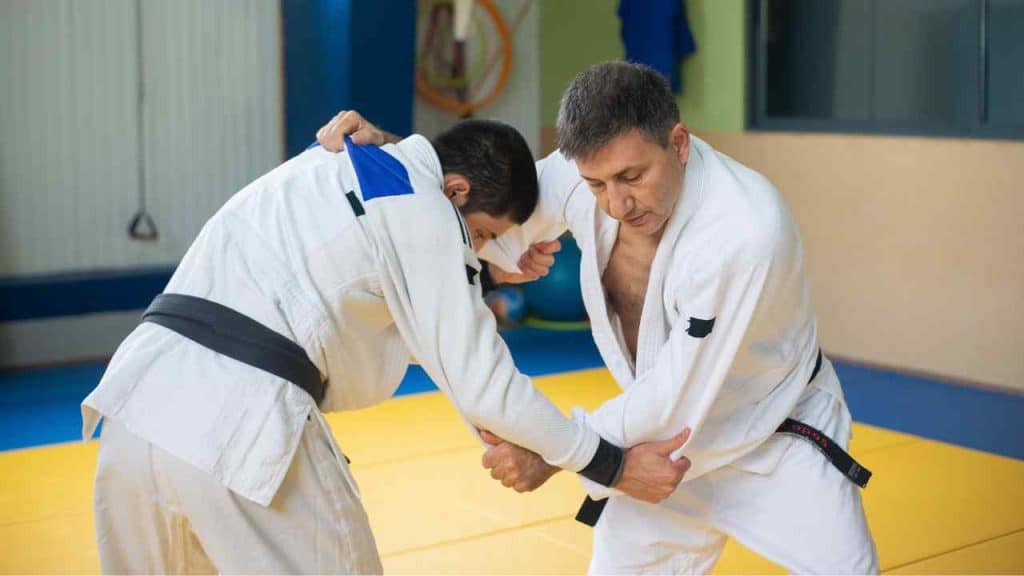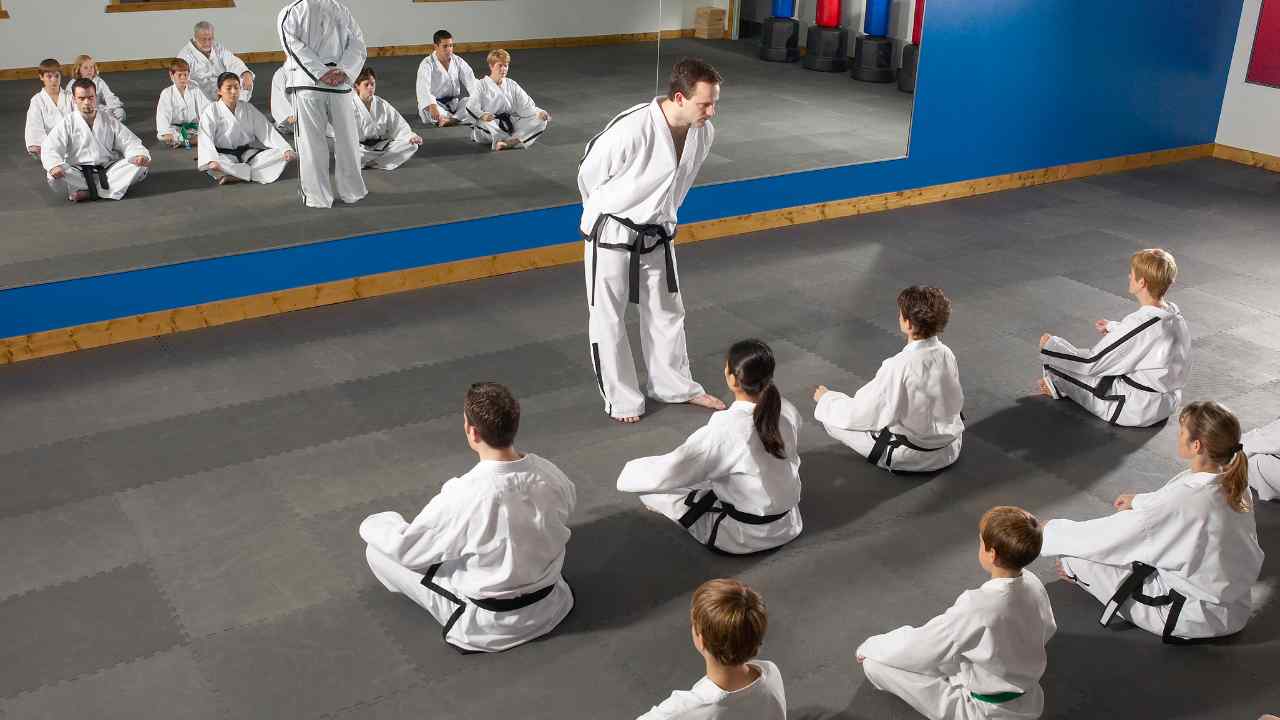As the Olympics have grown, so has the addition of various martial arts within the games. Every four years, martial arts fans specifically seek them out to watch the action.
Let’s dive into the history of martial arts in the Olympics and discuss each one in detail. We’ll review the history of each combat sport and its legacy in the Olympics.
What Martial Arts Are In The Olympics?
There are currently seven martial arts in the Olympics. These martial arts are judo, greco-roman wrestling, freestyle wrestling, boxing, karate, taekwondo and fencing.
Olympic Boxing

A Brief history of boxing
Boxing has been practiced for thousands of years, but modern boxing began in the late 1800s. This was after the Queensberry Rules of boxing were established.
The sport of boxing would become one of the very first martial arts that was marketed to the public. Due to this marketing, boxing became one of the most popular sports in the world and is still very popular.
The history of boxing in the Olympics
Boxing was first added as an Olympic sport in 1904. During that time, there were various rule changes and weight classes implemented in the event.
For many years, headgear wasn’t used, then headgear was added, then removed again. Women’s categories were added during the 2012 Olympics.
Overview of Olympic Boxing Rules
- 3 rounds at 3 minutes each
- No headgear
- Win by: KO, TKO, & decision
- Only punches above the belt and front of the body are permitted
- The Boxer that lands the most punches wins the round
Judo

A Brief history of Judo
Jigoro Kano created Judo in the late 1800s. The martial art is a form of grappling based on technique and leverage.
These techniques were so effective that Judo quickly became popular in Japan. Kano would then send his best students around the world to teach his martial art.
This strategy paid off as Judo became an internationally practiced martial art in a very short time. Judo would later be turned into more of a sport, which Kano was initially opposed to.
The history of Judo in the Olympics
Judo was added as an official Olympic event in 1964. During that time, a lot has changed in the Judo event.
Since its addition to the Olympics, weight classes were added, dangerous techniques were banned, and women’s categories were added to the games.
Overview of Olympic Judo
- Men’s matches are 5 minutes & women’s matches are 4 minutes
- Regulation Judo Gis are required
- Win by: Ippon, 2 waza-aris, 1 hansoku penalty, or 4 shido penalties
- Golden score is implemented in a sudden death period, where the first point wins the match
Taekwondo

The history of taekwondo
Taekwondo was developed after WW2, when Japan lost control of Korea. Korean martial arts masters got together to discuss creating a national martial art.
The martial art was created to help Korea reclaim its identity after over 30 years of being under Japanese rule. Taekwondo is a heavy-kicking martial art based on various Chinese and Japanese martial arts and Taekkyon (a traditional Korean martial art).
Taekwondo was able to expand rather rapidly in its first three decades of existence. A Taekwondo world championship would first be held in the early seventies and later an Olympic event.
There are now an estimated 50 million Taekwondo practitioners worldwide.
The history of Olympic Taekwondo
Taekwondo had its trial as an Olympic sport during the 1988 Seoul Games in South Korea. Twelve years later, it would become an official Olympic sport in 2000. Since 2000, it has been one of the most watched events at the Olympics.
Overview of Olympic Taekwondo
- Match: 3 rounds, 2 minutes each
- Fighters wear Taekwondo headgear, chest protector, gloves, and foot guards
- 1 point for punches to the trunk
- 2 points for a kick to the trunk
- 3 points for a head kick
- 5 points for turning kick to the head
- 1 point for a penalty by an opponent
- Win by points, TKO, or 20-point lead
- Gold Point is implemented if the match ends in a tie
Karate

The history of Karate
The martial art of Karate was developed within the islands of Okinawa during the early 19th century. It was based on native Okinawan martial arts and a version of Chinese boxing.
Developed as a defensive martial art, Karate is known for its powerful short combos of punches and kicks thrown as counters.
Gichin Funakoshi is considered to be the father of modern Karate, who developed Shotokan Karate. He developed the first forms that were practiced in Karate and helped them get included in schools within Okinawa.
Once Karate was introduced to mainland Japan, people quickly embraced the art of Karate. After World War 2, Karate was taught to westerners and spread around the globe.
From that point on, Karate became one of the most practiced martial arts in the world.
The history of Karate in the Olympics
Karate is the most recent martial art to be included in the Olympics. It was added at the 2020 Tokyo Games.
Overview of Olympic Karate
- 3 Minute Round
- Competitors compete in a Karate Gi.
- Hands, head, chest, feet, and shins are protected
- Yuko: 1 point for punches to the face or body
- Waza-ari: 2 points for kicks to the midsection
- Ippon: 3 points for kicks to the head or scoring technique where the opponent falls
- Win by: KO/TKO, points, or disqualification
Greco Roman Wrestling

The history of Greco-Roman wrestling
Greco-Roman wrestling was created in the 1800s by Jean Exbrayat. He was a wrestler who worked in French fairs and welcomed all challengers to test his wrestling skills.
He developed a wrestling style where you could only hold above an opponent’s waist. The term Greco-Roman wrestling was coined by a Greek wrestler named Basilio Bartoletti.
Greco-Roman gained popularity throughout Europe and, for a time, was the most popular form of wrestling globally.
The history of Greco-Roman wrestling in the Olympics
Thanks to the popularity of Greco-Roman wrestling, it was adopted into the Olympic games in 1896. Making it the oldest martial art that is an official Olympic event.
Overview of Olympic Greco-Roman Wrestling
- Two periods that are 3 minutes each
- Wrestling singlet with shoes must be worn.
- Only techniques above the waist
- Win by pin, points, or DQ
- 8 point lead is an automatic win
- Takedowns: 2-5 points(5 points for perfect takedown)
- Reversal 1 point
- Exposure: 2-3 points
- Penalties: 1-2 points
- Out of bounds: 1 point
Freestyle Wrestling

The history of freestyle wrestling
Freestyle wrestling was developed in the later 1860s after the US Civil War. Various styles of wrestling, from catch wrestling, Irish collar and elbow, and Lancashire wrestling, would influence the creation of freestyle wrestling.
Freestyle wrestling meets would be held throughout US cities starting in the 1880s.
The history of freestyle wrestling in the Olympics
Freestyle wrestling became the second martial art in the Olympics when it was added in 1904. At first, the only participants were Americans, but the wrestling style would soon catch on.
During the 1900s, freestyle wrestling overtook Greco-Roman wrestling as the world’s most popular form of wrestling.
Overview of Olympic freestyle wrestling
Freestyle wrestling has a similar format to Greco-Roman wrestling. The main differences being takedowns below the waist are permitted, and a 10-point lead is an automatic win.
Martial Arts In The Olympics
There are currently seven martial arts in the Olympics. These are:
- Boxing
- Judo
- Greco-Roman Wrestling
- Freestyle Wrestling
- Taekwondo
- Karate
- Fencing
These combat sports are exciting to watch in the Olympics and are regularly the most viewed events. Hopefully, we’ll see more martial arts added to the Olympic Games in the future.


